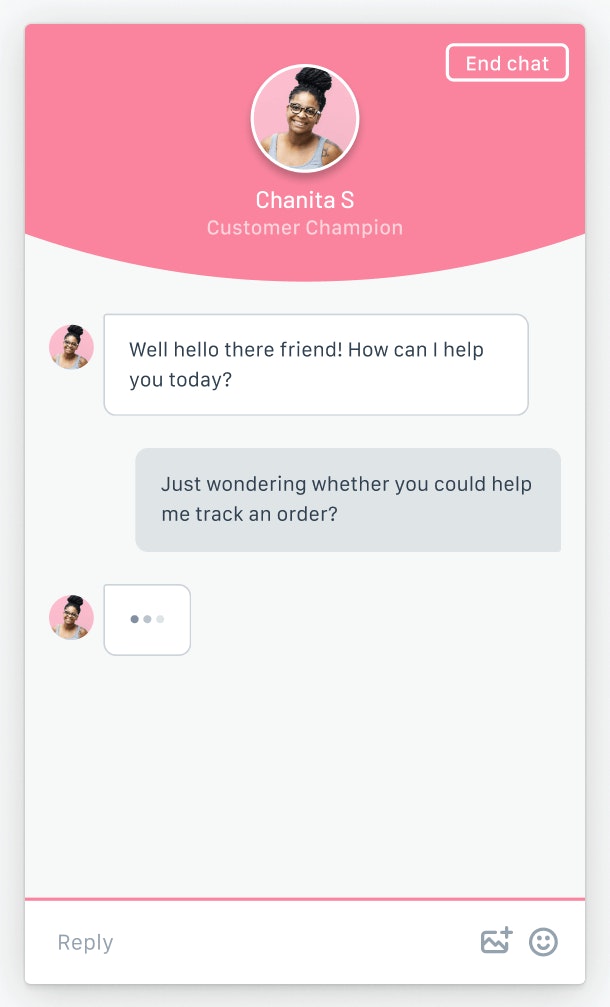Live chat support combines real-time conversation with the ability to share links, collect information, and save a full transcript for later reference, and it is the ideal online service tool for a customer who needs immediate help.
Getting started with live chat support is simple, but making live chat a sustainable, effective part of your customer service strategy takes careful thought and effort. Read on to learn why live chat support matters, how to add it to your support mix, and what it takes to deliver a great live chat support experience.
This is a chapter in our Ultimate Guide to Live Chat Support. When you're ready, check out the other chapters:
Chapter 1 – Live Chat Support 101: Definition, Benefits, and Best Practices
Chapter 2 – Key Live Chat Statistics for Customer Service Teams
Chapter 3 – How to Implement Live Chat With a Small Support Team
Chapter 4 – The Big Benefits of Live Chat for Customer Service Teams
Chapter 5 – Important Live Chat Tips for Email Support Pros
Chapter 6 – 101 Best Live Chat Response Examples for Customer Service
Chapter 7 – The Best Live Chat Tools for Customer Support
Chapter 8 – 5 Reasons Why Every Ecommerce Store Needs Live Chat
Chapter 9 – Live Chat Best Practices and Common Mistakes
Chapter 10 – Why Contextual Support is Critical to Live Chat
Chapter 11 – Why You Don’t Need an AI Support Chatbot
Chapter 12 – Actionable Live Chat Metrics to Start Tracking Today
What is live chat support?
Live chat support is a way for customers to have real-time, back-and-forth conversations with support agents. Using live chat software embedded on a company’s website, customers can send their questions to a person who can quickly reply to them in the same small window.

Live chat software is also used for purposes beyond support for things like enabling sales conversations. However, live chat software that is built specifically for customer support may include additional support-focused features, such as deep integration with knowledge base and shared inbox tools.
The benefits of live chat as a support channel
Why should you offer live chat support to your customers? Because customers love it! Studies show that live chat is the preferred choice of many customers, and it has the highest customer satisfaction level of any support channel.
Considering the key benefits of live chat support can help you decide whether it is the right choice for your business.
Live chat support is highly accessible
Live chat software can be integrated right into your customer’s workflow through a consistently available button or link on your website or in your app. Your customer doesn’t need to hunt down a special contact page or dig up an email address; they know exactly where to go when they need help.
That accessibility reduces customer effort, an important factor in building customer loyalty.
Live chat support delivers useful context
Embedding live chat right into the customer’s process gives them the best chance of explaining exactly where they are stuck and what they need.
Good live chat software will let the agent know where the customer is in the process and what they were doing before asking for help. That gives both parties a head start in understanding the problem and determining the solution.
Live chat support is timely
A customer who receives an excellent response to their email enquiry in an hour or two may be satisfied with your service, but a customer who receives the exact same answer in real-time via a live chat will often be much happier because they can continue on with their task immediately.
If your customer is considering making a purchase, renewing their account, or asking for a refund, a solid answer provided quickly can make a real financial difference to your company.
Live chat support is conversational
Many people are more comfortable expressing themselves through chat conversation than through more formal writing. Effective email support puts demands on the customer to explain their issue clearly and provide all the relevant details, tasks at which customers are not always experts.
Live chat support breaks those interactions into smaller chunks and allows the support agent to lead a customer through the process by asking the right questions in the right order. What could be a days-long, back-and-forth conversation through email might instead be a 10-minute chat.
Of course, you can’t just switch on live chat and expect to see the benefits instantly flowing in. Rolling out live chat support requires some careful planning and intentional design.
Adding live chat support into your customer service experience
Adding a brand new support channel to your service offering isn’t a step to take lightly. Often, you will be taking your existing resources (your team, their working hours, and their set of skills) and giving help across more locations. That can be a stretch.
Before you leap into offering live chat support everywhere at once, consider these questions:
Who will you offer live chat support to? You don’t need to make chat an option for every customer or prospect who visits your site. Perhaps you offer live chat to your VIP clients or to newly onboarding customers.
Where is live chat support most valuable? Are there pinch points in your app or sales funnel where having a real-time conversation can help people get unstuck and maintain their momentum? Consider providing live chat support only at those moments, at least initially.
How will you balance your support channels? Look at the time and skills you have to work with, and decide how many hours you can feasibly cover with live chat support. Compare that to the support volume you have incoming through your other channels, and decide on a sustainable mix between them all. You won’t get it right the first time, but you can make an educated guess.
How will live chat integrate with your existing help desk or CRM? The more you know about your customers and their past history with you, the better service you can offer. Choose a live chat support tool that will connect each chat conversation with what you already know about that customer so you don’t lose valuable context.
What training or resources will you need? Give your team the best possible chance to succeed by reviewing their backgrounds and skills and providing them with some guidance on what good chat support looks like. Giving great service through live chat is a different skill set than email or even phone support.
As you integrate your new live chat support channel, begin collecting data about what is working, how customers are reacting, and where your team might need additional help to deliver the best possible support experience.
Live chat support best practices
Delivering consistently great customer service through live chat is not easy, but it doesn’t have to be complicated. We’ve spoken to customer service folks about their experiences and collected the following best practices.
Live chat support best practices as a manager
If you’re responsible for setting up and managing the live chat support channel, there are some moves you can make to improve the experience for your staff and for your customers.
Keep the incoming volume manageable. Your customers look to chat for quick, accessible interaction with your team. If your chat team struggles to keep up, the customer experience will suffer. Use reporting to keep an eye on the overall volume and response time, and take action if needed. Consider offering chat only during certain time windows or to certain customer groups to control volume.
Don’t overload your individual support agents. A typical support agent can handle two or three concurrent chats without losing service quality, but that depends heavily on the type of questions they are answering and the levels of experience of both customer and agent. You should be able to set a maximum chat number so that no one team member is overwhelmed with chat requests.
6 live chat customer service best practices for agents
Here are the six best practices any live chat support agent will need to follow in order to deliver consistently good service.
1. Manage the conversation
Like being on the phone with that one aunt, chats can spin out of control. Being able to bring a chat back to the purpose of the conversation is helpful. Pro tips:
Get on the same page — make sure you and your customer are both talking about the same thing.
Set expectations — let them know if you need to step away or if they will need to wait.
Build boundaries — have prepared responses for tough situations, like customers being abusive.
Switch channels smoothly — if you need to move a chat to email or phone, do it gracefully.
2. Increase your speed
In live chat, responsiveness counts for a lot. It’s better to share the first part of your answer and build your customer’s confidence than to wait until your whole answer is ready. Pro tips to speed up your chat support:
Improve your typing speed — is it time to give Mavis Beacon one last job?
Remove friction — can you replace clunky manual support processes or add context for your staff?
Use TextExpander or saved replies — there’s no need to type it all out every time!
Build out self-service — A well-stocked, searchable knowledge base, with text and video, can save you and your customer a ton of time.
3. Write concisely
Live chat is not the place for long exposition. Conciseness is a skill you can learn! Start with these tips:
Know your stuff — with strong product and domain knowledge, you can quickly decide what is important for this customer to know and what can be safely left out.
Cut the fluff — you can usually leave those complex edge cases and historical explanations for the long-form knowledge base articles.
Use simple language — avoid using internal names, industry jargon, and marketing phrases.
Be specific — refer to what your customers can see for themselves, using the words they will recognize.
4. Chunk information
If you’re an email support pro, you might have learned to include all the relevant information at once to avoid long back-and-forth chains. Live chat is conversation, so back-and-forth discussion is a benefit! A couple of key points:
Ask small questions — you can draw out the information you need piece by piece.
Introduce one idea at a time — keep it simple and bite-sized.
Listen and adjust — when you see your customer respond, you can tell if they are on track or if you need to take a different approach.
5. Teach your customers
Don’t restrict yourself to only answering the specific question your customer asked. Look for opportunities to understand what they are trying to do and why, and share your knowledge. For example, share an alternative answer that might suit them better or some setup tips specific to their particular needs.
6. Close it out
Don’t ghost on your customers! Make sure that you bring each chat to a helpful, clear closing point. A good live chat ending should:
Confirm the customer has what they need.
Leave them with clear directions (if they need to take any action).
Thank them for their time.
Let them know how to get further help if they need it.
Have better customer conversations through live chat support
High-quality service goes beyond simply providing the correct information into understanding what a customer is trying to achieve and helping them get it done.
Live chat support can speed up that process by allowing for a more natural conversational style, where a skilled support agent can ask the right questions at the right time and quickly direct a customer to where they need to be.
The right live chat support software will allow you to combine real-time chat support with self-service options and an email contact point, allowing for many different support experiences according to the preferences of the customer and the capabilities of the support team.






